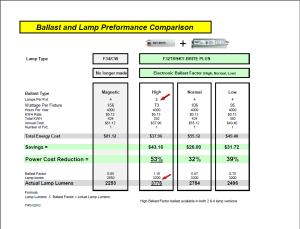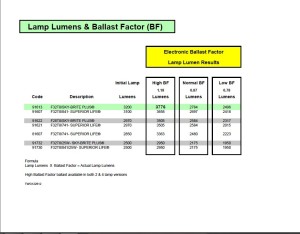New Ballast Energy Standards to Take Effect November 2014
Lighting: New Ballast Standards 2014
The Department of Energy (DOE) issued new rules regulating the efficiency of fluorescent lamp ballasts, which takes effect November 2014. The rulemaking creates a new metric for measuring ballast efficiency and establishes a higher standard of efficiency that will impact many of today's fluorescent T8, T5 and T12 ballasts. Ballasts that do not comply will be prohibited from manufacture and import, but existing inventories can be sold until they are exhausted. The following ballast types are at greatest risk:
- Majority of T12 electronic ballasts;
- Majority of outdoor-sign and residential-only ballasts; and
- T8 and T5 programmed-start ballasts lacking a cathode “cutout” design.
More info at:
http://lightingcontrolsassociation.org/new-ballast-energy-standards-coming-in-2014/
Commercial Lighting Tampa FL, 813-935-4448 / 813-932-1547
CommercialLightingTampa.com, 8139354448 / 8139321547
Lamp Lumens and Ballast Factor 101-1
Commercial Lighting Tampa FL, 813-935-4448 / 813-932-1547
CommercialLightingTampa.com, 8139354448 / 8139321547
Lamp Lumens and Ballast Factor 101
Commercial Lighting Tampa FL, 813-935-4448 / 813-932-1547
CommercialLightingTampa.com, 8139354448 / 8139321547
T12 toT8, Simplifed Wiring for your customer
Wiring Diagram
Upgrading from T12 lamps to T8 lamps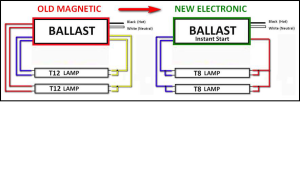
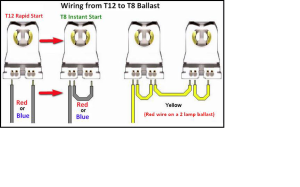
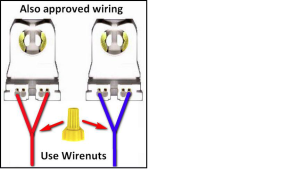
By Shunting the lamp socket (making both contacts common to each other) both pins on the lamp have a positive electrical contact with the one lead wire to each lamp socket.
When upgrading from T12 lamps to T8 lamps a four (4) lamp ballast is also an option.
Replace any defective lamp holders.
Commercial Lighting Tampa FL, 813-935-4448 / 813-932-1547
CommercialLightingTampa.com, 8139354448 / 8139321547
The United States Environmental Protection Agency
Has revamped some of the CFL and LED specifications.
There is a 30 page report and a 2 page cover letter.
Here is an example of some of the bullet points from the cover letter.
- The commercial grade performance tier proposed in Draft 2 has been removed in response to concerns that its implementation would create potential complications in the marketplace with existing “commercial” lighting products, as well as potentially confuse consumers. The Agency believes the new features of the advanced certified products list will allow users to screen and search for specific performance attributes such as lifetime, CRI and Power Factor, to better meet individual programmatic needs.
- Allowable product variations have been added to the specification to reduce testing burden, and additional testing requirements, if any, have been clarified for certain variations.
Did you pick up the part about “Potential Complications,” “Commercial Lighting Products,” and “Potentially Confuse Consumers.”
Well, we certainly don't want to “confuse consumers” by letting them know about “Commercial Grade Performance.”
Commercial Lighting Tampa FL, 813-935-4448 / 813-932-1547
CommercialLightingTampa.com, 8139354448 / 8139321547
How to Replace the Ballast in a Fluorescent Lighting Fixture
All fluorescent light fixtures consist of at least lamp(s), lamp holders, ballast and internal wiring. Some older types have "starters", too. The ballast is used to create the voltage and current necessary to start and illuminate the fluorescent lamp. In time, the ballast may need to be replaced. Read on to learn how to swap out the old with an approved replacement ballast of the same technology. Please read the entire article and warnings before attempting.
Before you go to the trouble of replacing the ballast, you should determine if a bad ballast is indeed the likely cause of the problem. First, replace the tubes with new tubes or with tubes that you know are good. Usually, if the lamps have turned black at one or both ends, they are bad (see photo right), but the only way to know for sure is to replace them with good ones. Note, however, that fluorescent lamps generally burn out gradually over time, not suddenly. If all of the tubes in a fixture stop working abruptly at the same time, it's likely that the problem is not the tubes.
If replacing the tubes does not fix the problem and if the light fixture has one or more "starters" (found only in older fixtures), replace the starters. There will be one starter per lamp (tube). The starter is a small cylindrical part (3/4-inch (20 mm) diameter x 1 1/4-inch (30 mm) long) that is twisted into a separate socket, usually located near the end of the fixture or behind a lamp. Starters are very inexpensive (about $2 each) and easy to replace. It is difficult to determine if starters are functional merely by inspecting them visually. Swap with a new or known "good" starter to check. If changing the tubes and starters does not correct the problem, the most likely culprit is the ballast.
Remove the lamps and place them in a safe location.
Turn the light off at the switch, as well as at the circuit breaker. (If you are not sure which breaker operates the light, shut off the whole house breaker to be safe.) Turn the metal tabs (see photo right) near the center of the fixture perpendicular to its length. It will fall away from the fixture. Pull it toward you and store it in a convenient place. Do the same with the other side.
-
-
Before you cut any wires, it is recommended that you check both the hot and neutral feed wires for voltage with respect to ground. (And see the alternative to cutting in step 11 before doing any cutting.) The voltage can be checked with a simple voltmeter or voltage sensor. Locate the ballast and follow the wires until you find the wire nuts (caps) that connect wires of the same color (red to red, etc.). If there are no wire nuts, you will have to cut the wires about 12 inches (300 mm) from the center of the fixture on each side. Complete this until all wires are cut or all wire nuts are removed.
-
5
Unscrew the nut holding the ballast to the fixture while holding it in place with your other hand. This is best done with a nut driver or socket wrench. Remove the ballast by lowering the side held by the nut, and sliding it in that direction.
-
6
Take the ballast with you to your local home center or hardware store and purchase a like replacement. Note the number of tubes in your fixture and their wattage, length, type (T8, T12, T5, etc.). Note also there may be two ballasts in a four-tube fixture, each ballast running two of the tubes.
-
7
Install the replacement ballast by reversing the instructions in step 5. Be sure the red and blue wire face the end with red and blue wires, and the black and white wires face the other end.
-
8
If you opt for the cutting method, cut the wires so they overlap the fixture wires by about 6 inches (150 mm).
-
9
Strip about 1/2" (12 mm) of insulation from the ends of all 8 of the wires.
-
10
Use a wire nut to connect the blue wire to the blue wire, the red to the red, the white to the white, and the black to the black. As a quick and easy alternative to cutting and wiring, simply rotate and pull the wires out of the lamp connectors. A little back and forth rotation (in the manner of a screwdriver) suffices, but is necessary otherwise the wires won't come out. Make a note of the wire colors when you pull them out. To connect the new ballast, simply push the wire into the hole from which you pulled the old wire out and give the wire a tug to make sure it's seated firmly, the same method as used at the factory.
-
11
Reverse step 3. Make sure the tabs are in the holes at the end of the fixture.
LED Street Lights Fail in the Rain
SAN ANTONIO – Earlier this year we told you the City of San Antonio and CPS Energy are spending more than $14 million of your money to replace street lights with energy saving LED fixtures. Now the News 4 WOAI Trouble Shooters have uncovered that all 25,000 of the fixtures had to be sent back to the manufacturer because of a glaring defect.
Close to 2,000 of the street lights are already up in a few areas around the city, but installations came to a halt a few weeks ago when some of the new fixtures began to fail. That wasn’t the first problem with the lights, either. Jaie Avila has the Inside Story on a program CPS Energy has been trying to keep in the shadows.
Every time you see something like this It has to make you wonder, was the buying decision base on price?
Commercial Lighting Tampa FL, 813-935-4448 / 813-932-1547
CommercialLightingTampa.com, 8139354448 / 8139321547
What is COB?
COB (Chips on Board) , is a new technology of LED packaging for LED light engine. Multi LED chips are packaged together as one lighting module. When it light up, it looks like a lighting panel..
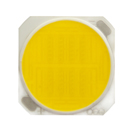
Why COB? –Background
LED(light emitting diode) is new technology with advantage of saving energy and very long lifespan. But all LED lightsource can not be faultless especially SMD, HP, flux LED etc. Compare to traditional lighting such as fluorescent lamp, as it is super bright in a small size, it cause uncomfortable glare. In case of no diffused optical lens used, such LEDs usually cause glare and zebra strips . But when optical lens or cover used, it will cause light loss when LED beam pass through this lens or cover.
How COB LED Light source works
COB LED is multi chips packaged, it can 10 times more increase lighting area, so it avoid uncomfortable glare by the maximum extent.
Lightspot use small size of chips to make COB LED package.
By now, for small size chip, ?some famous LED chip manufacturer can reach 249lm/watt @ 20mA. But big size LED chip can only reach 161lm/watt @350mA. The light efficacy decrease when chip size is bigger. Also when LED driver increase current to LED, the light efficacy per watt is even low.
The COB with small size chips will be a trend of LED light source package.
Lightspot holds the patent for invention for COB LED and lamp.
Commercial Lighting Tampa FL, 813-935-4448 / 813-932-1547
CommercialLightingTampa.com, 8139354448 / 8139321547
So what kind of gas is in a fluorescent lamp?
So what kind of gas is in a fluorescent lamp?
Surprisingly not many people in the lighting business know.
Mercury-vapor
Commercial Lighting Tampa FL, 813-935-4448 / 813-932-1547
CommercialLightingTampa.com, 8139354448 / 8139321547
Inrush Current and Solid State Lighting
In the early 80’s with the advent of the first electronic CFL lamps we learned of the detrimental effect of power surges and something called Inrush Current.
At a condominium complex with several identical buildings only one would burn out these lamps very quickly. It was discovered that every time the elevator started the voltage would drop and then comeback with a force of 132+ volts and soon the lamps failed. Power problem corrected and so was the lamp problem.
Commercial Lighting Tampa FL, 813-935-4448 / 813-932-1547
CommercialLightingTampa.com, 8139354448 / 8139321547
Call Us Today!
813-514-1266
813-935-4448
8135141266
8139354448

